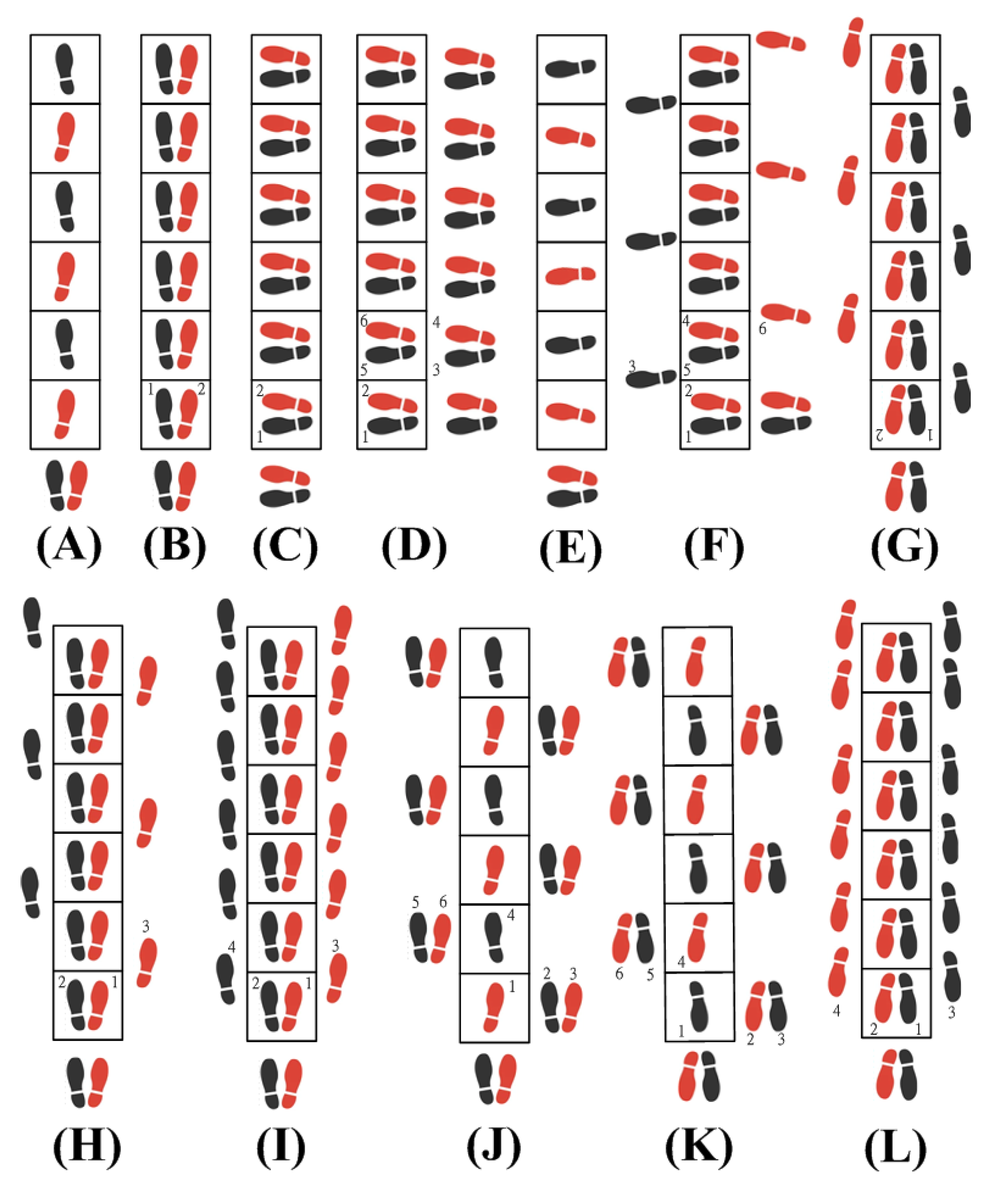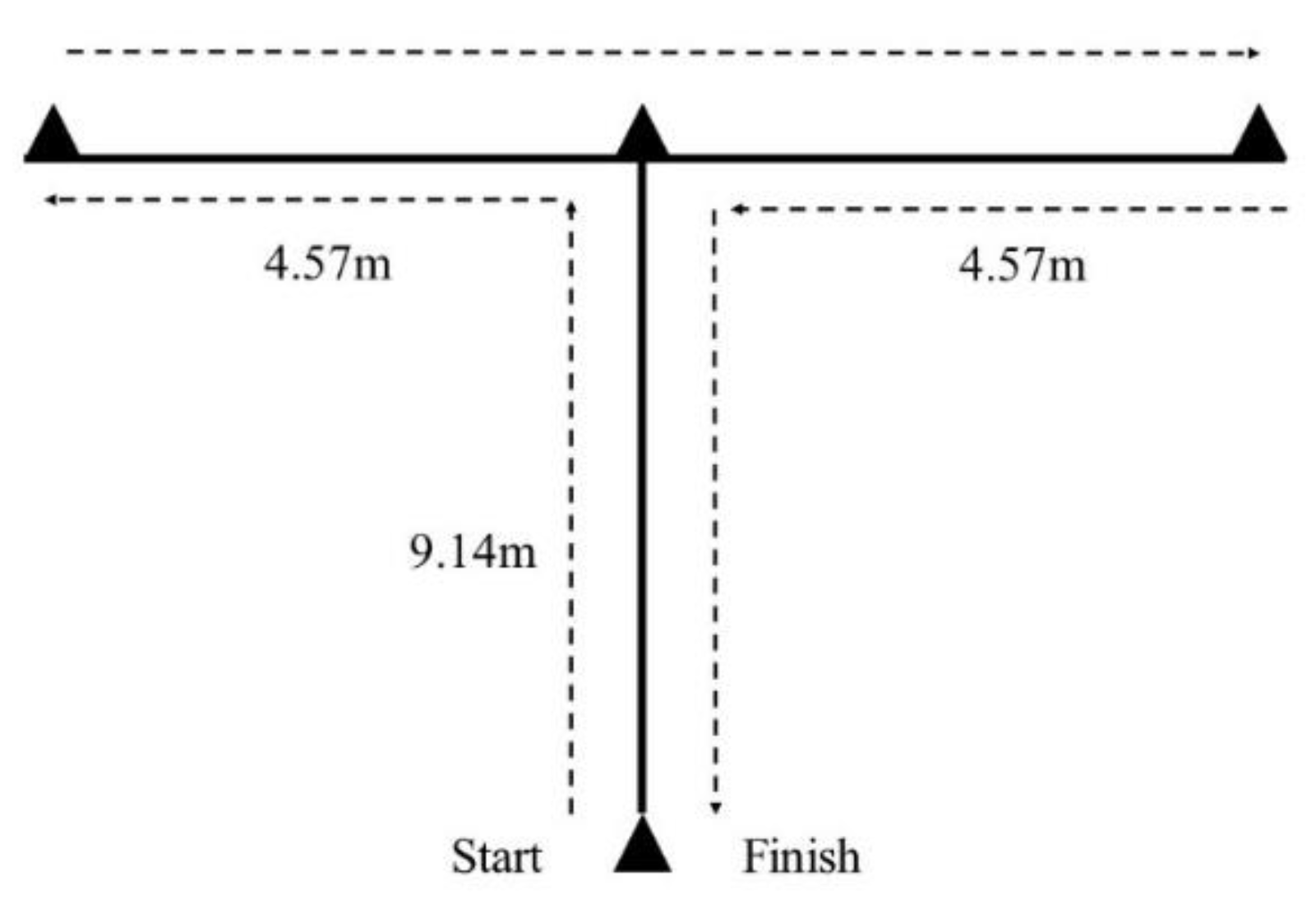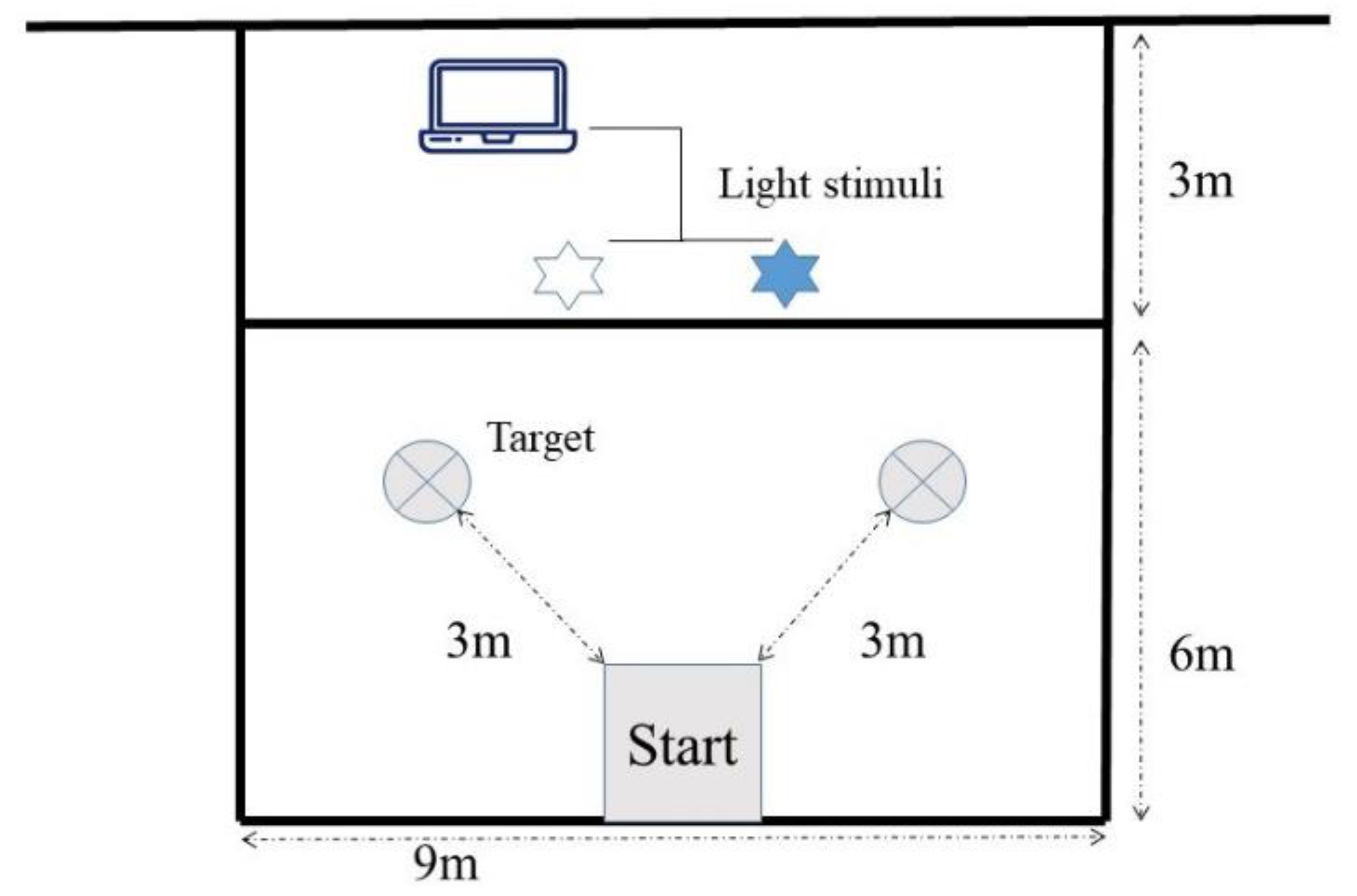Effects of Agility Training on Skill-Related Physical Capabilities in Young Volleyball Players
Abstract
1. Introduction
2. Materials and Methods
2.1. Study Subjects
2.2. Agility Training Procedure
2.3. Testing Procedure
2.3.1. Agility T-test
2.3.2. 10 m Sprint (10 MS)
2.3.3. Digging Agility Test (DAT)
2.4. Data Processing and Statistical Analyses
3. Results
4. Discussion
5. Conclusions
Author Contributions
Funding
Institutional Review Board Statement
Informed Consent Statement
Data Availability Statement
Conflicts of Interest
References
- Munro, A.G.; Herrington, L.C. Between-Session Reliability of Four Hop Tests and the Agility T-Test. J. Strength Cond. Res. 2011, 25, 1470–1477. [Google Scholar] [CrossRef] [PubMed]
- Cronin, J.B.; Hansen, K.T. Strength and Power Predictors of Sports Speed. J. Strength Cond. Res. 2005, 19, 349–357. [Google Scholar] [CrossRef] [PubMed]
- Young, W.B.; James, R.; Montgomery, I. Is muscle power related to running speed with changes of direction? J. Sports Med. Phys. Fit. 2002, 42, 282–288. [Google Scholar]
- Young, W.; Farrow, D. A Review of Agility: Practical Applications for Strength and Conditioning. Strength Cond. J. 2006, 28, 24. [Google Scholar] [CrossRef]
- Ho, C.-S.; Lin, K.-C.; Chen, K.-C.; Chiu, P.-K.; Chen, H.-J. System design and application for evaluation of blocking agility in volleyball. Proc. Inst. Mech. Eng. Part P J. Sports Eng. Technol. 2016, 230, 195–202. [Google Scholar] [CrossRef]
- Marković, G.; Sekulic, D.; Marković, M. Is agility related to strength qualities?—Analysis in latent space. Coll. Antropol. 2007, 31, 787–793. [Google Scholar] [PubMed]
- Paul, D.J.; Gabbett, T.J.; Nassis, G.P. Agility in team sports: Testing, training and factors affecting perfor-mance. Sports Med. 2016, 46, 421–442. [Google Scholar] [CrossRef] [PubMed]
- Turna, B. The Effect of Agility Training on Reaction Time in Fencers. J. Educ. Learn. 2020, 9, p127. [Google Scholar] [CrossRef][Green Version]
- Farrow, D.; Young, W.; Bruce, L. The development of a test of reactive agility for netball: A new methodology. J. Sci. Med. Sport. 2005, 8, 52–60. [Google Scholar] [CrossRef]
- Ho, C.-S.; Lin, K.-C.; Hung, M.-H.; Chang, C.-Y.; Chen, K.-C. System design and application for evaluation of digging agility in college male volleyball players. Proc. Inst. Mech. Eng. Part P J. Sports Eng. Technol. 2019, 233, 424–431. [Google Scholar] [CrossRef]
- Wang, M.H.; Chen, K.C.; Hung, M.H.; Chang, C.Y.; Ho, C.S.; Chang, C.H.; Lin, K.C. Effects of plyometric training on surface electromyographic activity and performance during blocking jumps in college division I men’s volleyball athletes. Appl. Sci. 2020, 10, 4535. [Google Scholar] [CrossRef]
- Miskin, M.A.; Fellingham, G.W.; Florence, L.W. Skill importance in women’s volleyball. J. Quant.-Tive Anal. Sports 2010, 6. [Google Scholar] [CrossRef]
- Hughes, M.; Daniel, R. Playing patterns of elite and non-elite volleyball. Int. J. Perform. Anal. Sport 2003, 3, 50–56. [Google Scholar] [CrossRef]
- Wu, C.C.; Wang, M.H.; Chang, C.Y.; Hung, M.H.; Wang, H.H.; Chen, K.C.; Ger, T.R.; Lin, K.C. The acute effects of whole body vibration stimulus warm-up on skill-related physical capabilities in volleyball players. Sci. Rep. 2021, 11, 1–7. [Google Scholar]
- Castro, J.; Souza, A.; Mesquita, I. Attack Efficacy in Volleyball: Elite Male Teams. Percept. Mot. Ski. 2011, 113, 395–408. [Google Scholar] [CrossRef]
- Palao, J.; Santos, J.; Ureña, A. Effect of the manner of spike execution on spike performance in volleyball. Int. J. Perform. Anal. Sport 2007, 7, 126–138. [Google Scholar] [CrossRef]
- Yap, C.W.; Brown, L.E. Development of speed, agility, and quickness for the female soccer athlete. Strength Cond. J. 2000, 22, 9. [Google Scholar] [CrossRef]
- Holmberg, P.M. Agility Training for Experienced Athletes: A Dynamical Systems Approach. Strength Cond. J. 2009, 31, 73–78. [Google Scholar] [CrossRef]
- Craig, B.W. What is the scientific basis of speed and agility? Strength Cond. J. 2004, 26, 13–14. [Google Scholar] [CrossRef]
- Barnes, M.; Attaway, J. Agility and Conditioning of the San Francisco 49ers. Strength Cond. J. 1996, 18, 10–16. [Google Scholar] [CrossRef]
- Wilderman, D.R.; Ross, S.E.; Padua, D.A. Thigh Muscle Activity, Knee Motion, and Impact Force During Side-Step Pivoting in Agility-Trained Female Basketball Players. J. Athl. Train. 2009, 44, 14–25. [Google Scholar] [CrossRef]
- Padrón-Cabo, A.; Rey, E.; Kalén, A.; Costa, P.B. Effects of Training with an Agility Ladder on Sprint, Agility, and Dribbling Performance in Youth Soccer Players. J. Hum. Kinet. 2020, 73, 219–228. [Google Scholar] [CrossRef] [PubMed]
- Miller, M.G.; Herniman, J.J.; Ricard, M.D.; Cheatham, C.C.; Michael, T.J. The effects of a 6-week plyometric training program on agility. J. Sports Sci. Med. 2006, 5, 459–465. [Google Scholar] [PubMed]
- Shondell, D.S.; Reynaud, C. (Eds.) The Volleyball Coaching Bible; Human Kinetics: Champaign, IL, USA, 2002. [Google Scholar]
- Sheppard, J.M.; Gabbett, T.; Taylor, K.L.; Dorman, J.; Lebedew, A.J.; Borgeaud, R. Development of a repeat-ed-effort test for elite men’s volleyball. Int. J. Sports Physiol. Perform. 2007, 2, 292–304. [Google Scholar] [CrossRef] [PubMed]
- Baechle, T.R.; Earle, R.W. (Eds.) Essentials of Strength Training and Conditioning; Human Kinetics: Champaign, IL, USA, 2008. [Google Scholar]
- Alemdaroğlu, U. The Relationship Between Muscle Strength, Anaerobic Performance, Agility, Sprint Ability and Vertical Jump Performance in Professional Basketball Players. J. Hum. Kinet. 2012, 31, 149–158. [Google Scholar] [CrossRef] [PubMed]
- Sahin, H.M. Relationships between acceleration, agility, and jumping ability in female volleyball players. Eur. J. Exp. Biol. 2014, 4, 303–308. [Google Scholar]
- Potteiger, J.A.; Lockwood, R.H.; Haub, M.D.; Dolezal, B.A.; Almuzaini, K.S.; Schroeder, J.M.; Zebas, C.J. Muscle power and fiber characteristics following 8 weeks of plyometric training. J. Strength Cond. Res. 1999, 13, 275–279. [Google Scholar]
- Wheeler, K.W.; Sayers, M.G. Modification of agility running technique in reaction to a defender in rugby union. J. Sports Sci. Med. 2010, 9, 445. [Google Scholar] [PubMed]



| Agility Ladder Drills (Repetitions × Sets) | Weeks 1–2 | Weeks 3–4 | Weeks 5–6 |
|---|---|---|---|
| Frontal one in, one out | 4 × 1 | ||
| Two in the hole | 4 × 1 | ||
| Two in lateral | 4 × 1 | ||
| Lateral two in, two out | 4 × 1 | ||
| One lateral | 2 × 2 | ||
| Lateral ickey shuffle | 3 × 2 | ||
| Ickey shuffle backward | 3 × 2 | ||
| Ickey shuffle | 3 × 2 | ||
| Frontal two in, two out forward | 3 × 2 | ||
| Zig-zag crossover shuffle | 3 × 2 | ||
| Zig-zag crossover shuffle backward | 3 × 2 | ||
| Frontal two in, two out backward | 4 × 2 |
| Item | Group | Pre-Test (CV) | ICC | Post-Test (CV) | ICC | F | p-Value |
|---|---|---|---|---|---|---|---|
| DATs | STG | 1.48 ± 0.08 (5.41%) | 0.95 | 1.39 ± 0.09 (6.48%) | 0.89 | 5.512 | 0.012 |
| ATG | 1.48 ± 0.05 (3.38%) | 0.95 | 1.42 ± 0.04 (2.82%) | 0.92 | |||
| CG | 1.48 ± 0.06 (4.05%) | 0.89 | 1.47 ± 0.06 (4.08%) | 0.90 | |||
| T-test | STG | 11.74 ± 0.32 (2.73%) | 0.81 | 11.43 ± 0.30 (2.62%) | 0.89 | 4.336 | 0.021 |
| ATG | 12.21 ± 0.34 (2.78%) | 0.91 | 11.81 ± 0.37 (3.13%) | 0.86 | |||
| CG | 11.84 ± 0.33 (2.79%) | 0.87 | 11.81 ± 0.36 (3.05%) | 0.82 | |||
| 10 MS | STG | 2.11 ± 0.12 (5.69%) | 0.96 | 1.99 ± 0.12 (6.03%) | 0.97 | 30.710 | 0.000 |
| ATG | 2.14 ± 0.07 (3.27%) | 0.94 | 2.07 ± 0.06 (2.90%) | 0.90 | |||
| CG | 2.14 ± 0.16 (7.48%) | 0.90 | 2.13 ± 0.11 (5.16%) | 0.87 |
Publisher’s Note: MDPI stays neutral with regard to jurisdictional claims in published maps and institutional affiliations. |
© 2022 by the authors. Licensee MDPI, Basel, Switzerland. This article is an open access article distributed under the terms and conditions of the Creative Commons Attribution (CC BY) license (https://creativecommons.org/licenses/by/4.0/).
Share and Cite
Chuang, C.-H.; Hung, M.-H.; Chang, C.-Y.; Wang, Y.-Y.; Lin, K.-C. Effects of Agility Training on Skill-Related Physical Capabilities in Young Volleyball Players. Appl. Sci. 2022, 12, 1904. https://doi.org/10.3390/app12041904
Chuang C-H, Hung M-H, Chang C-Y, Wang Y-Y, Lin K-C. Effects of Agility Training on Skill-Related Physical Capabilities in Young Volleyball Players. Applied Sciences. 2022; 12(4):1904. https://doi.org/10.3390/app12041904
Chicago/Turabian StyleChuang, Chia-Hung, Min-Hao Hung, Chi-Yao Chang, Yung-Yi Wang, and Kuo-Chuan Lin. 2022. "Effects of Agility Training on Skill-Related Physical Capabilities in Young Volleyball Players" Applied Sciences 12, no. 4: 1904. https://doi.org/10.3390/app12041904
APA StyleChuang, C.-H., Hung, M.-H., Chang, C.-Y., Wang, Y.-Y., & Lin, K.-C. (2022). Effects of Agility Training on Skill-Related Physical Capabilities in Young Volleyball Players. Applied Sciences, 12(4), 1904. https://doi.org/10.3390/app12041904







